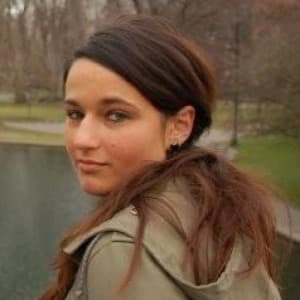Advertisement
In Mission Hill, Kennedy's Final Act As People's Champion
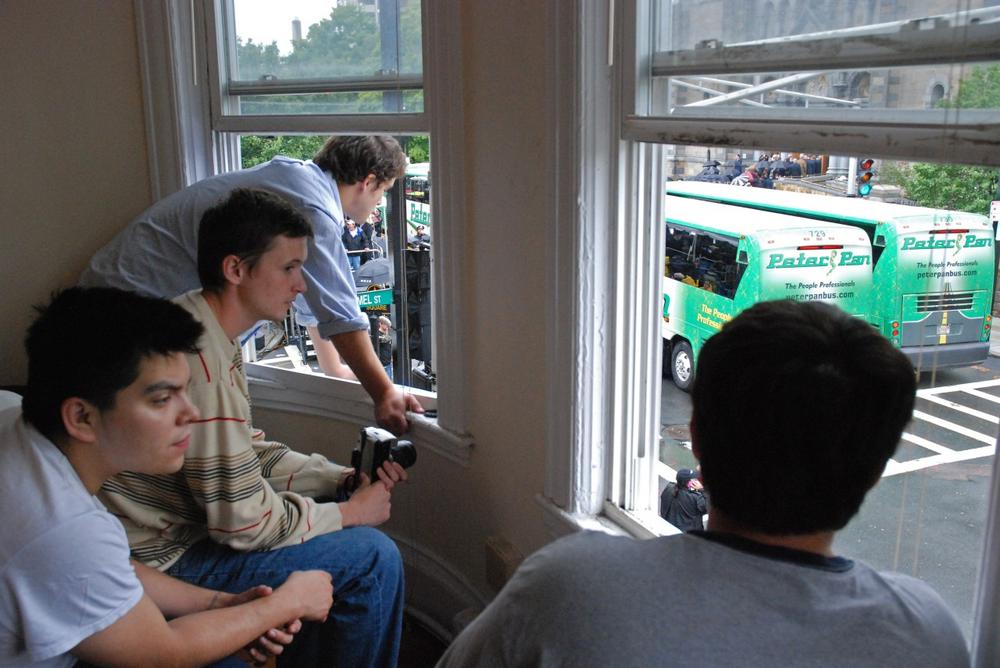
THE OLD MISSION HILL
Robert Francey expects you to be surprised that Sen. Edward M. Kennedy chose for his funeral to be held at a church in Mission Hill, a working-class neighborhood little-known outside the city. This is, after all, the patriarch of the Kennedy family, with a compound in posh Hyannisport.
But having lived here a long time, Francey is not at all surprised. Honored, yes; surprised, no.
It’s not to say that Francey knew of the senator’s connection to Mission Hill. An active member of the neighborhood, and a man who delights in throwing around the names of local politicians, even Francey had not known that Kennedy once spent nearly every day in Mission Hill.
“Very few of us knew that this neighborhood meant so much to him, or this church,” Francey says.
It was while his daughter, Kara, was battling lung cancer at a nearby hospital that Kennedy developed his connection to the Basilica of Our Lady of Perpetual Hope. The senator would attend the church at 1545 Tremont Street to pray for Kara’s recovery. She lived, and the basilica came to represent a place of hope and optimism. The senator returned to the church during his own cancer battle.
"For people of Mission Hill, it's not unusual," Francey says of Kennedy's fondness for the neighborhood. "Politicians have always felt comfortable coming here. Especially into Mike's Donuts."
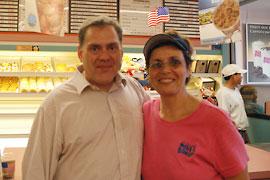
That's the no-frills donut shop where Francey is sitting, enjoying a cup of coffee, directly across from the basilica, at around 9:30 on Saturday morning. Kennedy's funeral is scheduled to begin in an hour.
"Aside from it being a major inconvenience, it's a great honor," Francey says. "Especially having lived here and seeing what bad press can do for a neighborhood."
It was in 1989 that the Roxbury neighborhood made a name for itself as the place where white businessman Charles Stuart fatally shot his pregnant wife, then inflamed racial tensions by blaming the crime on a black man.
Ten years ago, “it had really become an awful place,” Francey says. The idea of a member of the Kennedy clan electing to have his funeral in Mission Hill “wouldn’t have even been considered.”
“It’s important for the face of Mission Hill to be seen through these eyes,” Francey says. “Its national image has been tarnished many times by other people's shortcomings, but Mission Hill has always been very proud of who they are.”
Francey says today is an incredible reward for the neighborhood, one of the most diverse sections of Boston, where the people are among the most appreciative of their senator, a man who championed the rights of the ignored and underprivileged — "the people on the second floor," as Kennedy called them.
Francey credits himself, in part, for the changes that have brought the neighborhood to where it is today. He is an outspoken member of the community, active in the Mission Hill Crime Committee and the Community Alliance of Mission Hill.
"It'll probably make people less afraid to come up here — the fact that Ted Kennedy used to walk right up Tremont Street and come pray here."
--Sean Smith
Mike’s Donuts owner Maria Weinograd calls Francey “the eyes of the neighborhood.” She lit up when Francey walked through the door of her shop. His order was on the table within seconds of his sitting down.
In 2006, disturbed by the amount of graffiti he was seeing on the fronts of businesses and houses around Mission Hill, Francey says he began making calls to Boston police, asking for help. For months those calls went ignored, he says, until he finally decided to take matters into his own hands. “We weren’t getting the services,” he says, “We had junkies and drunks up and down the streets.”
So, Francey says, he went out with a bucket of white paint and started covering up the graffiti himself. And that’s when he says people started paying attention. The Boston Globe did a write-up of Francey’s crusade. And eventually, he says, the city got involved.
That civic spirit was instilled in him, Francey says, by none other than the late senator and his two slain brothers. “Hearing the stories as I watched the service at JFK last night, it was obvious to me why I am the person I am right now,” Francey says. “Because of what the Kennedys have always pushed for, the type of ideals.”
Francey says his mother was a big fan of the Kennedys, and he was brought up with John, Bobby and Teddy as role models — “spoon-fed the Kennedy doctrine,” as he puts it. “My mother was a foot soldier in the rights of the little guy.”
THE NEW MISSION HILL
Just upstairs, Joe Bachynsky and Rodrigo Esperon are leaning out a window of their apartment, with their friend from down the block, Sean Smith, watching with rapt interest as the media fills the street below.
The men, all juniors at Northeastern University, are seated in pop-up lawn chairs, pulled up close to three large windows that look out onto Tremont Street and the basilica below. A tube television tuned to Fox News sits in the center of the room. Old food wrappers and spent beer cans litter the floor.
They've taken over the only room with a view of the street below, the bedroom of their roommate, who's not here today, having spent the night out and not made it back in time to beat the police barricades. These 21-year-olds are not on their computers, they say, because the roommate has forgotten to pay the Internet bill.
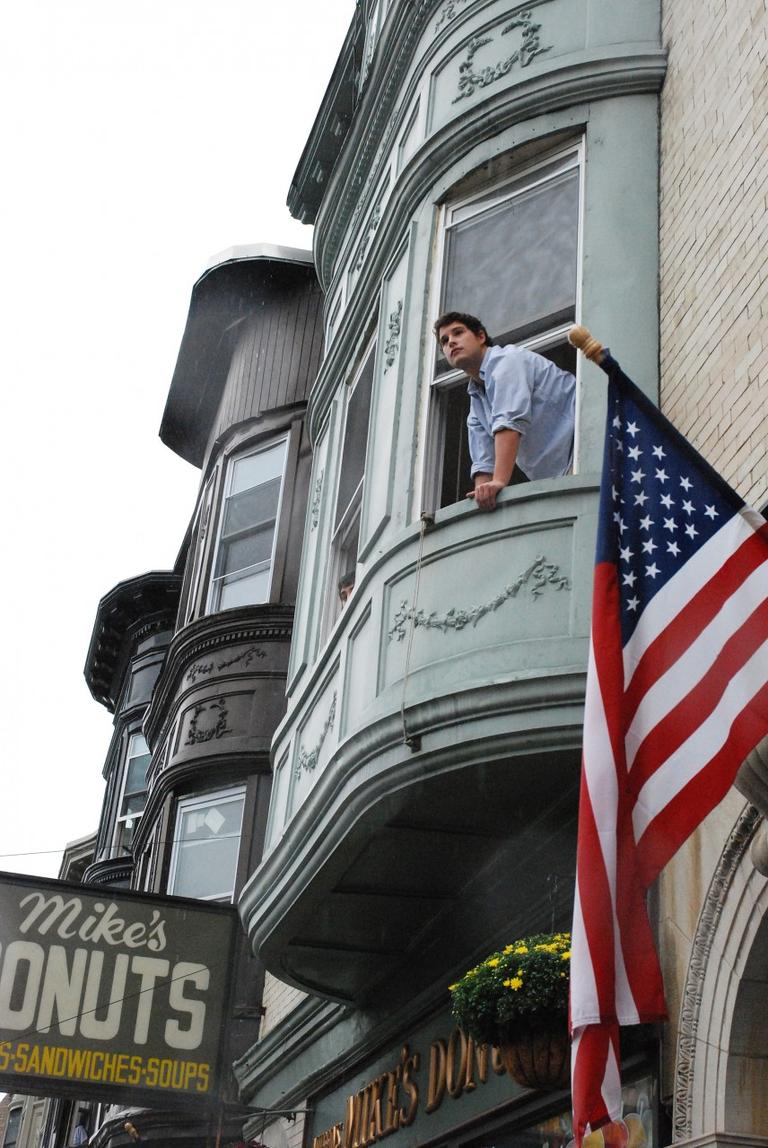
“We’re so young,” Sean says, watching the parade of presidents, senators and stars make their way to their seats inside the church, "we don't really understand it."
Born decades after the Age of Camelot had come to an end, the name Edward M. Kennedy had held little personal significance to these students, who had known him only in his political role as the Senate's liberal lion.
But the relentless media coverage over the past few days has opened their eyes, to some degree.
“You can just tell that everyone had so much respect for him,” Joe says, leaning back in his lawn chair, feet propped up against the windowsill, a beer in his hand.
As 10:30 nears, and anticipation over the arrival of the Kennedy motorcade builds, the young men crowd the windows, jostling for the best view. From time to time, someone turns to glance at the television. “I'm a little bit taken aback to see this outside my window, and then look at the TV and see it there,” Joe says.
Reporters and photographers, biding their time before the motorcade's arrival, routinely swing their cameras up to capture these young men in the window. At one point, the men turn to the television to find they’re looking at themselves — a slightly-delayed image of themselves — their heads poking out of the apartment, the old Mike’s Donuts sign and a row of American flags beneath them on Tremont.
Everyone pulls out cell phones to call their parents.
In hoping to glimpse one of the countless American icons to grace their neighborhood that morning — President Obama, Bill Clinton, Jesse Jackson, Jack Nicholson — the young men themselves become incidental icons of the day, if only for their luck in real estate. Their images appear live on the TV screens of millions watching the procession at home, and then again the next morning, in newspapers such as the Boston Globe and The New York Times.
And, in the end, it is this rare attention on Mission Hill — not the death of the senator — that is of most interest to these young men.
Sean calls it a “forgotten-about” neighborhood. “You say ‘Mission Hill,’ a lot of people don’t really know,” he says. “And then you tell them where it is, and they think it’s a really dangerous area.”
Mission Hill used to be mostly Irish Catholic. Then new waves of immigrants from other parts moved to the neighborhood, and significant African-American, Hispanic and Asian communities formed. In recent years, it has become a destination for young professionals and college students, like John, Rodrigo and Sean.
The young men moved to the neighborhood because the rent is cheaper than some of the other traditional neighborhoods for Northeastern students, like the Fenway and the South End. And they like it here. It has more soul, they say.
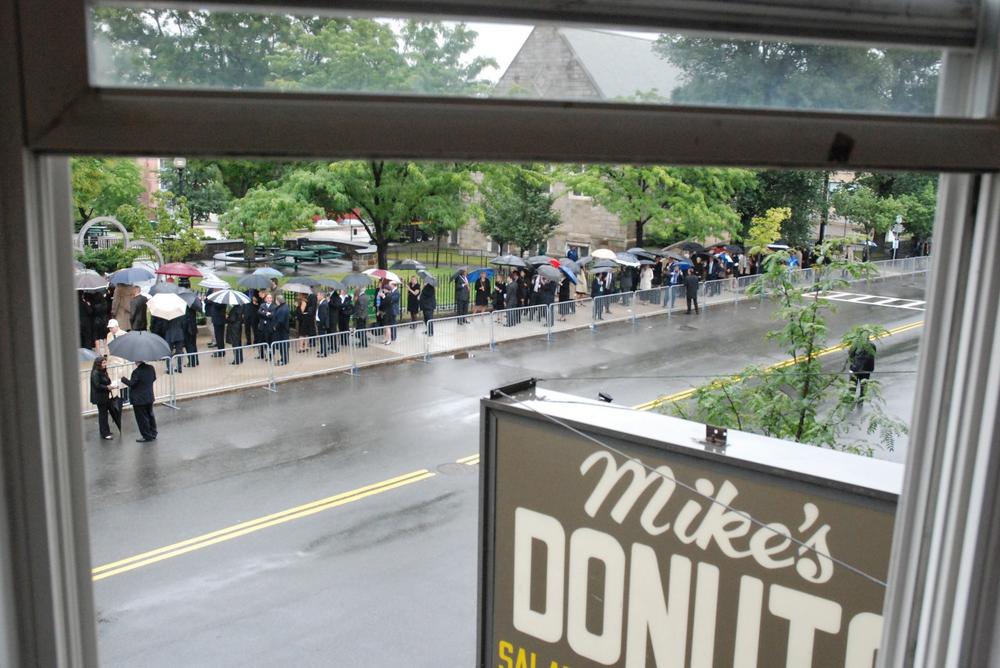
But to a lot of people in Boston, the idea of Mission Hill as an attractive place to live does not register. “People gasp,” Sean says, when he tells them where he lives, “especially the ladies I work with.”
Their fear isn't entirely unwarranted. In May of last year, another Northeastern student, 22-year-old Rebecca Payne, was found dead in her Mission Hill apartment, shot twice in the legs and once in the chest. People in the neighborhood said they heard gunshots, but no one called 911.
"I heard four to five gun shots. I didn't pay to mind to it because I hear gun shots a lot, so it was like, whatever," one resident of Payne's apartment complex told The Huntington News, Northeastern's twice-weekly newspaper. The case has not been solved.
But John, Rodrigo and Sean all say they feel safe in their neighborhood. Maybe, the men say, people from outside Mission Hill will start to feel safe there, too, now that it has become known around the world as the chosen site of Kennedy's funeral.
Within hours of the announcement that Kennedy’s funeral would be held at Mission Church, Public Works rolled in and got to work on the whitewash that Bob Francey had always dreamed of.
Flowers were planted, light poles were painted, bushes and hedges were trimmed, concrete was repaved.
The men had observed with amusement the speedy and dramatic makeover, which began less than 72 hours ago. “I thought it was really funny to watch the cleanup happen, because usually it’s broken glass and garbage,” Sean says.
“I don’t know if it’ll have a lasting impact,” he adds, pointing out that the beautification only goes a couple blocks down the road, before it's glass and garbage as usual.
“But it’ll probably make people less afraid to come up here — the fact that Ted Kennedy used to walk right up Tremont Street and come pray here.”
More than that, Kennedy chose to spend his last day above earth here. It's a fitting last act for the man who lived his life as a giant for the little people.
This program aired on August 31, 2009. The audio for this program is not available.
